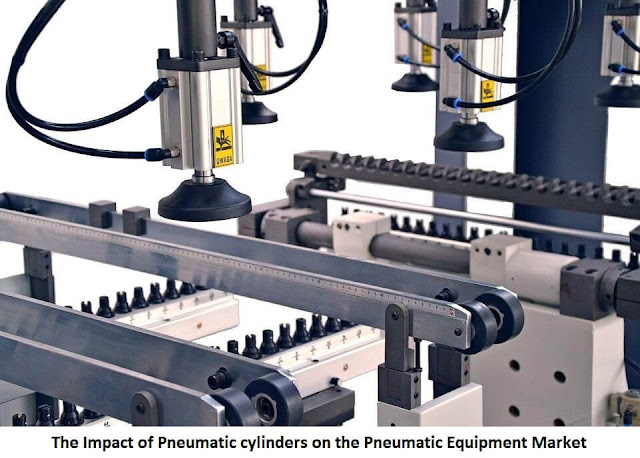The market for pneumatic equipment has been
witnessing a steady growth for the last few years across the world. This has
been attributed to the rapid pace of industrialization in Asian countries as
well as the evolving market in the U.S. and Europe. As per estimates, by 2024,
the Pneumatic equipment market is predicted to reach the total valuation of
$55.89 billion with a CAGR of 5.4 percent. North America is the largest market
for pneumatic equipment and contributes to more than 44 percent of the market
revenue. Many industries such as cement, paper & pulp, oil & gas,
mining etc are using pneumatic equipment on a regular basis and are driving the
growth of the market.
Brazil, Chile, and India are also seeing growth in the market for pneumatic
equipment as many new as well as established companies are entering these
economies through mergers and acquisitions.
What is Pneumatic
cylinder equipment?
compressed gas in order to produce a reciprocating linear force are called
Pneumatic cylinder equipment. They are also sometimes referred to as air
cylinders.
required direction, the piston rod forces the compressed air to move. Since
these cylinders are clean, quiet and can store liquid fluid in smaller space,
they are referred to as pneumatics.
Market Analysis and Size
to be dominated by Europe until 2020. The other regions such as the Middle East
and Africa along with Asia Pacific regions will also see growth at a faster
annual rate till 2022.
on increasing productivity and reducing harmful manual tasks, the demand for
pneumatic equipment will increase substantially.
In 2018, the value of the pneumatic equipment market was estimated at $40.8
billion and in 2024, it is predicted to reach the valuation of $55.90 billion.
safety of mine workers in the developed regions such as Western Europe and
North America, the demand for pneumatic cylinders is going to increase. This
trend is signaling towards an increase in the partnership with automation
suppliers of this equipment.
Growth depending on
sectors and regions
India due to higher demand for this equipment. Due to the demand for pneumatic equipment in the Middle East, Africa, and the Asia
Pacific region, the opportunities for global service providers in these markets
has risen.
such as oil exploration, offshore mining, mine safety etc, these regions are
leading the trend of automation of pneumatic equipment and are leaving behind
the conventional methods that were unsafe and harmful.
The demand for this equipment is going to be sustained by the upcoming
greenfield and brownfield projects in various sectors such as power generation
and the oil & gas industry.
growth of the pneumatic equipment market are the automation and miniaturization
of the equipment design along with technological advancements, which enhance
its efficiency manifolds.
Procurement strategies
equipment are mining, chemicals, and oil & gas, contributing to almost 49
percent of the market share. The increasing consumption of processed and
packaged food is also driving the growth of pneumatic cylinders market sales.
With the increasing needs and demands of the customer, more consumers are
preferring global suppliers for higher quality. The global suppliers also help
in the standardization of this equipment and in the reduction of the delivery
times. Only a couple of vendors are selected as they can help in improving the
design of the machines in an efficient manner. As the number of suppliers for
pneumatic cylinders would be limited, it will also improve the negotiation
powers.
Engagement Model
pneumatic equipment market is a straightforward process and involves the
following steps: –
buyers prepare a list comprising of the names of the preferred suppliers of
components. The basis of preparation of this list is either advice from experts
or previous user experience.
this list is handed over to the integrators. Instructions are forwarded to them
to use components only from prescribed vendors.
process of sourcing and procurement of the components is managed by the
integrators on behalf of the customers.
there are any issues related to warranty or repair, they are also handled by
the integrators. Therefore, integrators play an important role in the
engagement model by being the single point of contact for any problem faced by
the customers.
regions. In the absence of any serious challenges facing the pneumatic
equipment market, it is expected to register a steady growth over the next few
years as well.



